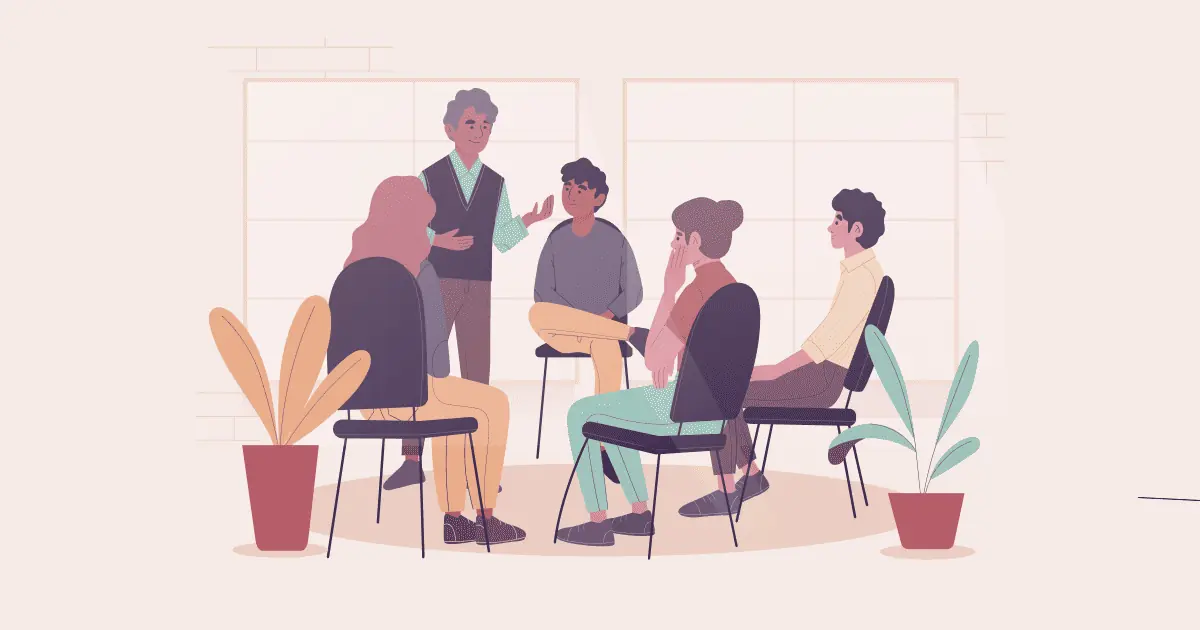你什麼 演講時的肢體語言 您對它有什麼看法?該做什麼,不該做什麼!快來 AhaSlides 學習最佳技巧吧!
那麼,最佳演講姿勢是什麼?你有尷尬的手症候群嗎?你可能沒有,因為我編的。但是──我們都會有不知道該怎麼擺放手、腿或身體任何部位的時候。
你可能有一個奇妙的 破冰船, 無可挑剔 介紹,以及精彩的演講,但交付才是最重要的。你不知道該如何應對自己,這完全 正常.
Overview
| 尷尬的肢體語言是什麼? | 向下凝視、控制微笑、轉過頭的動作和觸摸臉部 |
| 羞恥的非語言表現有哪些? | 耷拉著肩膀,低著頭,低著頭,沒有眼神交流,說話前後不一致 |
| 觀眾能看出演講者何時害羞嗎? | 可以 |
| 賈伯斯的演講為何如此精彩? | 他只是練習了很多,並且感興趣 演示服裝 |

提高參與度的技巧
你對成功的演示了解多少?除了精心設計的 PowerPoint 範本外,運用其他表演技巧也很重要,尤其是肢體語言。
現在您知道肢體語言是演講技巧中不可替代的一部分,但要掌握這些技巧來進行有效的演講還遠遠不夠。
本文將為您全面介紹肢體語言以及如何利用這些技巧進行完美的簡報。
目錄
肢體語言對於演講的重要性
在肢體語言演示中,當談到溝通時,我們會提到口頭和非口頭術語。重要的是要記住這些術語之間存在相對關係。那麼,它到底是什麼呢?
言語溝通是指用語言與他人分享訊息,包括口語和書面語言。例如,你選擇用「最近怎麼樣?」這個詞來問候,就是為了讓別人明白你想問什麼。
非語言溝通是透過肢體語言、臉部表情、手勢、營造空間感等方式傳遞訊息。例如,與人見面時微笑,可以傳達友善、接納和坦誠。
無論你是否意識到,當你與他人互動時,除了說話之外,你還在不斷發出和接收無聲信號。你所有的非語言行為——你的姿勢、你的語調、你的手勢以及你的眼神交流——都在傳遞重要的訊息。
它們尤其能讓人感到安心,建立信任,吸引註意力,也有可能冒犯或擾亂你試圖表達的內容。這些訊息也不會因為你停止說話而停止。即使你保持沉默,你仍然在進行非語言溝通。
同樣,演講也是與聽眾溝通的一種方式;在闡述你的想法時,運用肢體語言來強調它。因此,同時理解非語言和語言溝通技巧的重要性,將有助於你避免演講的枯燥乏味。
為了更直觀地理解,我們探討了肢體語言的元素,它是非語言溝通技巧的一部分。肢體語言包括手勢、站姿和臉部表情。當你演講時,積極有力的肢體語言是建立信譽、表達情感和與聽眾建立聯繫的強大工具。它還能幫助聽眾更專注於你和你的演講。在這裡,我們為你提供了10多個肢體語言範例和技巧,幫助你更好地利用你的肢體語言。
掌握演講中肢體語言的10個技巧
考慮你的外表
首先,在演示過程中必須保持整潔的外觀。 根據不同的場合,您可能需要準備合適的服裝和整齊的頭髮,以顯示您的專業水平和對聽眾的尊重。
考慮活動的類型和風格; 他們可能有嚴格的著裝要求。 選擇一套你更有可能在觀眾面前感到泰然自若和自信的服裝。 避免使用可能會分散觀眾注意力、發出噪音或在舞檯燈光下造成眩光的顏色、配飾或珠寶。
微笑,再微笑
微笑時不要忘記“用眼睛微笑”,而不僅僅是用嘴巴。 這將有助於讓別人感受到你的溫暖和真誠。 記住即使在相遇之後也要保持微笑——在虛假的幸福相遇中; 你可能經常會看到一種“開關”式的微笑,這種微笑在兩個人分道揚鑣後一閃而過又迅速消失。
張開手掌
做手勢時,確保雙手大部分時間都張開,以便別人能看到你張開的手掌。此外,最好保持手掌大部分時間向上而不是向下。
眼神接觸
與觀眾中的個別成員進行目光接觸通常是一個壞主意! 有必要找到一個「足夠長」的最佳時間點來注視你的聽眾,而不會讓他們感到冒犯或令人毛骨悚然。 試著看別人大約 2 秒鐘,以減輕尷尬和緊張。 不要為了與聽眾建立更多聯繫而查看筆記。
查看提示 溝通中的眼神交流
手緊握
當您想結束會議或結束與某人的互動時,您可能會發現這些手勢很有幫助。 如果您想表現出自信,可以在伸出拇指的情況下使用此提示——這表示自信而不是壓力。
刮刀
在親密朋友和信任的人面前,偶爾把手插進口袋放鬆是件很舒服的事。但如果你想讓對方感到不安全,把手深深地插進口袋絕對是個致命的辦法!
摸耳朵
當一個人焦慮時,會下意識地觸摸耳朵或做出自我安慰的動作。 但是你知道它是遇到觀眾疑難問題的好幫手嗎? 在思考解決方案時觸摸您的耳朵可能會使您的整體姿勢更加自然。
不要指指點點
無論你做什麼,都不要指指點點。確保你永遠不要這麼做。說話時指指點點是禁忌,這不僅發生在演講中。人們總是覺得這很具攻擊性,讓人感到不舒服,甚至有點冒犯。
控制你的聲音
在任何演講中,都要緩慢而清晰地講話。當你想強調要點時,可以放慢語速並重複。語調很重要;讓你的聲音起伏,讓你聽起來自然。有時,為了更好地溝通,可以暫時保持沉默。
隨便走走
演講時走動或停留在一個地方是可以的。但不要過度走動;避免一直來回走動。當你想吸引觀眾,或是在講一個有趣的故事,或是觀眾笑的時候,走動一下。
4個肢體語言技巧
在本文中,我們將介紹一些有關肢體語言以及如何提升演講技巧的快速提示:
- 眼神接觸
- 手和肩膀
- 遺產
- 背部和頭部
你的肢體語言至關重要,因為它不僅能讓你 看 更有自信、果斷、鎮定,但你最終也會 感覺 這些事情。說話時也應該避免低頭。
眼神-演講時的肢體語言
別 像躲避瘟疫一樣躲避眼神接觸。很多人不懂眼神接觸,被教導要盯著後牆或別人的額頭。別人能察覺你沒有看著他們,會覺得你緊張又疏離。我曾經也是那樣的演講者,因為我認為公開演講和表演沒什麼兩樣。高中時我參與戲劇演出時,他們鼓勵我們看著後牆,不要與觀眾互動,因為這會讓他們脫離我們創造的幻想世界。我吃過苦頭才明白,表演和公開演講是不一樣的。它們之間有相似之處,但你不想擋住觀眾的視線——你想讓他們參與進來,所以為什麼要假裝他們不在場呢?
另一方面,有些人被教導只看一個人,這也是一種壞習慣。 一直盯著一個人看會使他們感到非常不舒服,而且這種氣氛也會分散其他觀眾的注意力。

DO 像正常對話一樣與人溝通。如果人們覺得自己沒有被重視,你怎麼會指望他們會願意與你互動呢?我從中學到的最有用的演講技巧之一 妮可·迪克(Nicole Dieker) 是人愛關注! 花時間與您的聽眾建立聯繫。 當人們感到主持人關心他們時,他們會感到自己很重要並受到鼓勵分享他們的情感。 將你的注意力轉移到不同的聽眾身上,以營造一個包容的環境。 特別是與那些已經在看著你的人互動。 沒有什麼比低頭看著正在看手機或程序的人更糟糕的了。
與朋友交談時盡可能多地進行眼神交流。 公開演講也是一樣,只是規模更大,人數更多。
手– 演講時的肢體語言
不要限制自己或想得太多。 有很多方法可以不正確地握住你的手,比如在你的背後(這會顯得咄咄逼人和正式),在你的腰帶下(限制運動),或者僵硬地放在你的身體兩側(感覺很尷尬)。 不要交叉雙臂; 這給人以防禦和冷漠的印象。 最重要的是,不要過度手勢! 這不僅會讓人筋疲力盡,而且聽眾會開始關注你一定有多累,而不是你演講的內容。 讓您的演示文稿易於觀看,因此也易於理解。

DO 將雙手放在中立位置。這個位置應該略高於肚臍。最成功的中立姿勢是一隻手握在另一隻手上,或只是用雙手自然的方式觸碰。手、手臂和肩膀是觀眾最重要的視覺提示。你 應該 手勢就像您在常規對話中的典型肢體語言。 不要成為機器人!
以下是一段簡短的視頻 史蒂夫·巴維斯特,我建議您觀看它來直觀地了解我剛才描述的內容。
遺產– 演講時的肢體語言
別 鎖住你的腿,站著不動。 不僅危險,而且會讓你看起來不舒服(讓觀眾不舒服)。 沒有人喜歡感到不舒服! 血液將開始在您的腿部積聚,如果不運動,血液將難以再循環到心臟。 這使您容易昏倒,這肯定是……您猜對了…… 不舒服. 相反,不要過度移動你的腿。 我參加過幾次演講,演講者前後搖擺,我非常注意這種分散注意力的行為,以至於我忘記了他在說什麼!

DO 用你的腿作為手勢的延伸。如果你想表達一個能引起觀眾共鳴的觀點,就往前走一步。如果你想在一個令人震驚的想法之後,給觀眾留下思考的空間,就退後一步。一切都需要平衡。把舞台想像成一個平面——你不該背對觀眾。以一種包容所有觀眾的方式行走,並四處走動,這樣每個座位都能看到你。
返回– 演講時的肢體語言
別 身體向內彎曲,肩膀下垂,頭部下垂,脖子彎曲。人們對這種肢體語言有潛意識的偏見,如果你表現得像一個防禦性強、害羞且缺乏安全感的演講者,人們就會開始質疑你作為演講者的能力。即使你不認同這些描述,你的身體也會表現出來。

DO 用你的姿勢讓他們相信你的信心。 站直,就像你的頭連接到天花板上的一根教繩。 如果你的肢體語言表現出自信,你就會變得自信。 您會驚訝於很少的調整會改善或惡化您的演講能力。 嘗試在鏡子中使用這些演講技巧,並親自看看!
最後,如果您對自己的演講有信心,您的肢體語言將會大大改善。 您的身體會反映出您對自己的視覺效果和準備工作的自豪程度。 AhaSlides 是一款非常好用的工具 如果您想成為更自信的演講者,並使用演講時觀眾可以訪問的即時互動工具來讓您的觀眾驚嘆不已。 最好的部分?它是免費的!
結語
那麼,演講中的肢體語言透露了你的哪些特質呢?讓我們利用這些技巧,思考如何將它們融入你的演講中。不妨在家裡的鏡子前練習,或是在熟悉的觀眾面前練習,並徵求他們的回饋。練習 完美。你將能夠掌握肢體語言,並從演講中獲得良好的結果.
額外提示:對於虛擬線上演示或戴著口罩,您可能會遇到肢體語言的困難;您可以考慮利用演示模板來吸引觀眾的注意力 100 多種 AhaSlides 類型的示範模板.
常見問題(FAQ)
演講時手該怎麼擺放
演講時,有意識地運用雙手非常重要,這樣才能給人留下正面的印象,並增強你的表達能力。因此,你應該保持雙手放鬆,手掌張開,運用手勢輔助演講,並與聽眾保持眼神接觸。
當向中立的觀眾進行演講時,為什麼我應該提出問題的兩個面向?
向中立的觀眾展示問題的雙方觀點至關重要,因為它有助於吸引觀眾,提高你的批判性思考能力,使你的簡報效果更好,也有助於提高可信度。
演講中應避免哪些類型的手勢?
您應該避免分散注意力的手勢,例如:說話誇張但與您的內容無關; 坐立不安,例如敲擊手指或玩弄物體; 用手指指指點點(表示不尊重); 交叉雙臂和令人驚訝且過於正式的手勢!







